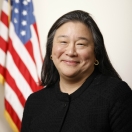
Today, the Office of National AIDS Policy, Office of the Vice President, and the White House Council on Women and Girls commemorate the 10th observance of National Women & Girls HIV/AIDS Awareness Day. Along with other Federal, national and community organizations and advocates, today we celebrate our accomplishments to date in improving the lives of women and girls affected by HIV, and recognize the work still ahead.
Our observance highlights the strides we have made in HIV prevention and care for women and girls across the United States. The introduction of antiretroviral drugs means that fewer women die from AIDS and pregnant women have reliable means by which to protect their babies from the virus. In fact, rates of mother-to-child transmission continue to fall, despite more women with HIV giving birth. Under the Affordable Care Act, new health plans are now required to cover HIV screening without cost sharing, for everyone aged 15 to 65, pregnant women, and others who may be at increased risk.
But our work is far from over: today, only about half of women living with HIV receive medical treatment, and only two in five have achieved viral suppression. Women face unique challenges and barriers to care, not the least of which is violence. Sexual assault and intimate partner violence (IPV) dramatically affect women’s access to HIV prevention and treatment. IPV, which often includes forced sex, increases a woman’s risk of contracting HIV and reduces her ability to demand prevention measures such as monogamy and condom use. In fact, women in abusive relationships have four times the risk of sexually transmitted infections, including HIV, than women in non-abusive relationships. Women in abusive relationships may delay testing and treatment out of fear of violence, and those who have been forced to have sex are less likely to ever have been tested for HIV. Women living with HIV who experience violence also have four times the rate of antiretroviral failure, compromising their long-term health even further.
Women who are HIV-positive are also at a higher risk of physical violence. Fifty-five percent of women living with HIV face intimate partner violence, double the national rate, and they risk provoking an abusive partner if they share their positive status.
It is easy to dismiss these as problems of other women, or other people. But they are issues that affect us all. Women from all walks of life are at risk — our mothers, sisters, daughters, nieces, friends, and coworkers. If we are to empower women to protect their health no matter their HIV status, we must address women’s unique HIV and IPV risks with targeted research and policy decisions.
That’s why in 2012, President Obama signed a Presidential Memorandum establishing a Federal interagency working group to begin addressing the intersection of these overlapping epidemics. Last October, we released the first annual update of implementation progress, and today we are proud to announce new actions by both Federal agencies and community organizations to implement our recommendations:
- The Departments of Justice (DOJ) and Housing and Urban Development (HUD) have collaborated to support a $9 million interagency agreement to fund transitional housing for women living with HIV that may be experiencing violence. Today, DOJ and HUD announced the release of the Federal notice for comment for these new grant opportunities that will be available later this spring.
- HHS Office of Adolescent Health has issued a new funding opportunity to support the launch of a national HIV/AIDS resource center which will provide innovative HIV prevention efforts for teens and adolescents. The new resource center will promote the implementation of evidence-based and best practices targeted to adolescent youth.
- The National Domestic Violence Hotline, funded by the HHS Administration for Children and Families (ACF), announced the results of their recent survey of users of their service, on knowledge of HIV risk factors, recent HIV testing, and knowledge about HIV services and resources—data that will inform gaps in knowledge among the community about the intersection of HIV and violence.
- The Institute on Domestic Violence in the African American Community (IDVAAC), which has also received funding from ACF, announced its commitment to convene four regional roundtables in high HIV prevalence neighborhoods to bring together leaders in the domestic violence and HIV fields in the local African American community to discuss, in conjunction with the local department of health, how HIV and domestic violence silos can be broken down at the local level for women at highest risk.
Now we ask that you join us by becoming part of a community that stands together to improve the lives of all women in the United States. Together, we will continue supporting women and girls, fighting for their right to health, safety, and well-being, and moving toward the goal of an AIDS-free generation.




